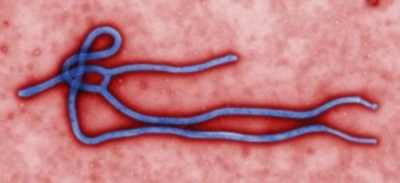 The Ebola virus, shown in an image released by US health officials, is just one of the possible diagnoses. Image AFP
The Ebola virus, shown in an image released by US health officials, is just one of the possible diagnoses. Image AFP
A man who has recently returned Africa has been isolated in a Canadian hospital with haemorrhagic fever. He is in a critical condition in Saskatoon.
61 people have died so far in an outbreak of Ebola in Guinea, there have also been cases reported in Liberia, the area the man is thought o have travelled to. His condition is said to resemble the diseases Lassa fever and Ebola, both of which have an incubation period of up to 21 days, though it more commonly falls between 4-16 days.
Ebola has no treatment and is fatal in up to 90% of cases. Lassa can be treated with Ribavirin.
There are five known strains of Ebola:
* Ebola Zaire: 80-90 % fatal.
* Ebola Sudan: 50% fatal
* Ebola Bundibugyo: 25% fatal
* Ebola Cote d’Ivoire: only 2 cases recorded, both survived
* Ebola Reston: no known human cases so far
Ebola Reston primarily affects primates and pigs. Five Filipinos have been found with antibodies to Reston in their system – they all work with pigs.
The natural reservoir for Ebola has not at this point been discovered, but based on other viral haemorrhagic diseases it is likely to be either bats, primates, rodents or insects.
Ebola is classified as a filovirus, and it appears as filaments under the microscope. It can be passed from human to human via blood, bodily fluids and in some cases respiratory secretions. It has an incubation period of 4-16 days which can make isolating victims difficult due to the time period that has elapsed after exposure.
The symptoms are harsh and come on very suddenly. Fever, severe headaches and muscle aches that cannot be relieved are rapidly followed by almost total loss of appetite.
Within a few days the virus causes disseminated intravascular coagulation, an odd condition marked by blood clots in the internal organs and haemorrhages elsewhere.
Violent vomiting and diarrhoea both containing blood and mucus arrive next and are accompanied by a severe sore throat and conjunctivitis.
A maculopapular rash (discoloured raised skin eruptions) appears on the trunk, rapidly spreading to the limbs and head. This precedes the final stage of the disease.
Prior to death, spontaneous haemorrhages occur, causing the body to bleed from every orifice and any wounds or injection sites that are present. Once the bleeding has begun, death usually follows quickly from either haemorrhagic shock (blood loss) or renal failure.
There is no known treatment for any strain of Ebola at this point in time. Currently care is mostly palliative and is aimed at keeping the patient as comfortable as possible. Intervention for those cases caught early enough is keeping electrolytes balanced and giving infusions of blood and plasma to try and control the bleeding.
Nursing Ebola patients should ideally be carried out in full biohazard suits as this is the only way to totally avoid contamination from a patient who is vomiting, bleeding and has no bowel control. If these suits are not available strict barrier nursing methods should be employed.
Dozens of flights a day bring home those who have vacationed in Africa, people returning to the west to visit friends and family, or returning from work, medical or missionary trips to the area, all have a possibility of transferring Ebola out of Africa. The fear is that this has now happened.
Ebola is one of the most feared diseases on the planet. With it’s incubation period being up to THREE WEEKS early detection is vital in controlling the spread of the disease.
No comment has yet been made about when the patient returned from Liberia, or if his contacts have yet been traced. The amount of people you come into contact with travelling through airports etc is staggering.
If the tests confirm the initial diagnosis, Ebola could already be incubating in scores of people who had contact with him and have now returned to their homes across the globe.
Take care
SOURCE : undergroundmedic.com


